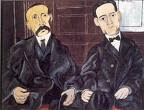
Written by Jámon Y. Huevos
Textbook Chapter Also Boring on Film
Filmmaker Peter Miller has garnered his first directing credit with the documentary Sacco and Vanzetti. The film recounts the sad tale of two Italian immigrant anarchists, Nicola Sacco and Bartolomeo Vanzetti, accused of murder and executed in Boston in 1927 after a trial filled with prejudice and the loud rally cries of the working class from, literally, all over the world. The film is told through the words of relatives and those who were children during the trial and execution; also, modern historians (none of whom list credentials explaining why we should listen to them) give their take on the events, while Tony Shalhoub and John Turturro read the letters of Sacco and Vanzetti.
The story is poignant and important even though the director and editor do everything they can to keep the film from being interesting in any way. Early on, we are shown the doorway to Sacco’s childhood home. Was the door to his house in a nice neighborhood? Did rowdy kids kick the door as they passed it? Was life behind the door particularly tough or loving? We can’t know; we can only know it is a red door and then we’re moving on to the next bit of partial information. A historian says that Vanzetti got along great with the children in the neighborhood where he was a fishmonger. Wonderful, but what does it mean? Should this information lead us to believe he was a good man and therefore not capable of murder?
The best moments in the film are when Shalhoub and Turturro read the private thoughts of Sacco and Vanzetti. Unfortunately, this is rarely done. We get about five letters from each of them, and they are obviously cut for time. Because of this, we never get the nuances of who these men were. We know they were anarchists, but their motivation is never made clear. We know the trial and rulings were specious and politically motivated, but we don’t get a clue as to why people would go so far to convict the wrong men. Over and over again, we are told that Sacco and Vanzetti met their untimely end because they were Italian. That’s definitely scary, especially in the light of current U. S. politics, but Miller won’t let you come to your own conclusions about the insight Sacco and Vanzetti might give us in regard to present-day civil liberties and the rights of immigrants. Instead, from the opening crawl, we are blatantly told to keep our eyes peeled for meaning. And, just in case we miss it, Miller shows us recent pictures from Iraq and Guantanamo Bay.
Out of nowhere, in the final minutes of the film, Miller attempts to change the direction of the documentary into a treatise on how the Sacco and Vanzetti trial influenced twentieth-century artists. Too bad not all the art influenced by the Sacco and Vanzetti tragedy is worth viewing.





